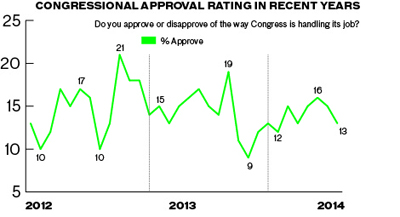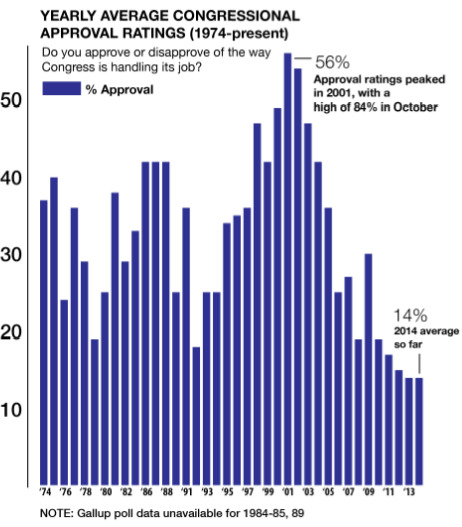When Congress was popular

If you’re not a paid staffer or blood relative, as the joke goes, you probably hate Congress.
The institution is so unpopular that voters were more positive about brussels sprouts, head lice and root canals in one recent survey. But there have been a handful of times over the last 100 years when the public gave a thumbs up to Capitol Hill.
{mosads}In 1937, 44 percent of those surveyed agreed that Congress was “about as good a representative body as it is possible for a large nation to have.” The number fell to 17 percent by 1990.
“The one thing we know for sure is that Americans usually don’t like Congress,” said Julian Zelizer, a professor of history at Princeton University.
What does it take for Congress to attract high approval ratings? To get answers to that complicated question, The Hill spoke with leading political scientists and analyzed survey data going back almost 80 years.
The following are five instances when Congress saw an upswing in approval and the experts’ perspective on why those swings took place.
The 2008 election
Congress can thank President Obama for its most recent surge in approval.
The institution gained almost 10 points as Obama and dozens of Democratic lawmakers took office in 2009, according to Gallup.
Ten points may not sound like much, but it was a notable hike given the negative attitudes about Congress during President George W. Bush’s second term.
Scott Keeter, director of survey research with the Pew Research Center, said the gains correlated with a sense of political unity, as the first black president was elected.
“Even Republicans marked the historic nature of Obama’s victory in surveys that we conducted,” Keeter said. “It was a period of hopefulness about the future. People were hoping against hope that the conflicts of the second Bush term would recede.”
Of course, those feelings haven’t lasted. Obama’s approval ratings are mired in the 40s, and congressional ratings are near historic lows.
 The enactment of Great Society programs
The enactment of Great Society programs
The mid-1960s represents the height of policy achievements for the Democratic Party.
President Johnson and strong Democratic majorities in the House and Senate led to the enactment of a wide array of landmark Great Society programs.
Political scientists say these achievements produced a strong sense of goodwill from the public, even though there is little reliable polling at that time.
“That was a peak for congressional approval,” said American Enterprise Institute scholar Norman Ornstein, co-author of It’s Even Worse Than It Looks, a book about political polarization. “While Republicans tended to oppose things like Medicare, the norms were different at the time and the programs ultimately got bipartisan support.”
Sept. 11, 2001, terrorist attacks
Congress has never been more popular than it was just after 9/11.
Approval of the institution shot from 42 percent to 84 percent within weeks of the tragedy, as the public rallied behind political leaders. It was an astonishing set of gains for Congress, but like most surges that take place in times of crisis, it did not last.
“What we’ve seen since 9/11 has been a fairly consistent downward trend,” said Ross Baker, professor of political science at Rutgers University. “Congress is slumping into the single digits. These job approval ratings are really without recent precedent.” 
The 1950s
Most assume that the public rallied behind Congress during World War II, but it took time for the darkness of that period to lift politically. Enter the 1950s, when peace and economic prosperity generated good feelings that stayed with Congress for more than a decade.
Sixty-four percent of the public rated Congress as “good” or “fair” at its job in 1953, a figure that rose eight more points by 1958.
“There’s no way around it. When you have a booming economy, people are more positive about their leaders. A rising tide lifts all boats,” said Frank Newport, Gallup’s editor in chief.
The late 1990s
Congress’s reputation saw similar gains in the 1990s as the dot-com boom boosted the economy.
Another pronounced jump took place at the start of 1998, when the Monica Lewinsky scandal was just beginning to erupt. But Congress lost some of its popularity in the subsequent effort to impeach President Clinton.
To congressional expert Jack Pitney, the lesson of the late 1990s is that even divided government can produce approval for Congress. President Clinton and the GOP-led Congress bickered a lot, but they also ironed out huge deals on welfare reform and the Balanced Budget Act of 1997.
“The public tends to like Congress when things are going really well, or when they’re going really badly,” said Pitney, a professor of government at Claremont McKenna College. “The more important thing is that, during much of the 90s, things were generally going well.”
Copyright 2023 Nexstar Media Inc. All rights reserved. This material may not be published, broadcast, rewritten, or redistributed.


